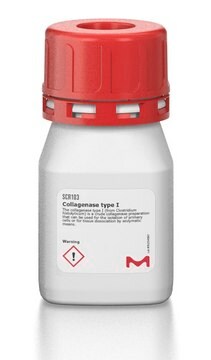1148090
USP
Colagenase
United States Pharmacopeia (USP) Reference Standard
Sinônimo(s):
Clostridiopeptidase A
About This Item
Produtos recomendados
grau
pharmaceutical primary standard
fabricante/nome comercial
USP
aplicação(ões)
pharmaceutical
Formato
neat
temperatura de armazenamento
−70°C
Procurando produtos similares? Visita Guia de comparação de produtos
Descrição geral
Ações bioquímicas/fisiológicas
Definição da unidade
Nota de análise
Outras notas
Palavra indicadora
Danger
Frases de perigo
Declarações de precaução
Classificações de perigo
Resp. Sens. 1
Código de classe de armazenamento
12 - Non Combustible Liquids
Classe de risco de água (WGK)
WGK 1
Ponto de fulgor (°F)
Not applicable
Ponto de fulgor (°C)
Not applicable
Escolha uma das versões mais recentes:
Certificados de análise (COA)
It looks like we've run into a problem, but you can still download Certificates of Analysis from our Documentos section.
Se precisar de ajuda, entre em contato Atendimento ao cliente
Já possui este produto?
Encontre a documentação dos produtos que você adquiriu recentemente na biblioteca de documentos.
Os clientes também visualizaram
Nossa equipe de cientistas tem experiência em todas as áreas de pesquisa, incluindo Life Sciences, ciência de materiais, síntese química, cromatografia, química analítica e muitas outras.
Entre em contato com a assistência técnica









